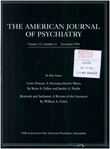Prospective study of neuroleptic-induced dystonia in mania and schizophrenia
Abstract
OBJECTIVE: The authors' goal was to conduct a prospective study comparing the rate of occurrence of neuroleptic-induced dystonia in a group of consecutively admitted manic and schizophrenic patients receiving typical inpatient treatment from several clinicians. METHOD: All patients met the following criteria: 1) male sex, 2) age between 17 and 45 years, 3) definite diagnosis of mania or schizophrenia according to Research Diagnostic Criteria, 4) no exposure to neuroleptics during the past month, 5) absence of past or family history of a neurodegenerative disorder with extrapyramidal symptoms. All treatment decisions were left to the treating clinicians. Fifty patients with mania and 33 with schizophrenia were included in the study. Most of these patients received high-potency neuroleptics, but the specific neuroleptic used varied in the two groups. RESULTS: Twelve (24%) of the patients with mania and five (15%) of the patients with schizophrenia developed acute dystonia. Manic patients received significantly higher peak doses of neuroleptics during the risk period for dystonia. Stepwise multiple regression analysis revealed that the peak neuroleptic dose and age were most strongly related to the occurrence of dystonia. CONCLUSIONS: This prospective study failed to support the retrospective finding of another study that acute dystonia occurred more often in manic patients than in patients with nonparanoid schizophrenia. The authors conclude that there is a need for carefully controlled prospective studies with larger groups of patients.
Access content
To read the fulltext, please use one of the options below to sign in or purchase access.- Personal login
- Institutional Login
- Sign in via OpenAthens
- Register for access
-
Please login/register if you wish to pair your device and check access availability.
Not a subscriber?
PsychiatryOnline subscription options offer access to the DSM-5 library, books, journals, CME, and patient resources. This all-in-one virtual library provides psychiatrists and mental health professionals with key resources for diagnosis, treatment, research, and professional development.
Need more help? PsychiatryOnline Customer Service may be reached by emailing [email protected] or by calling 800-368-5777 (in the U.S.) or 703-907-7322 (outside the U.S.).



